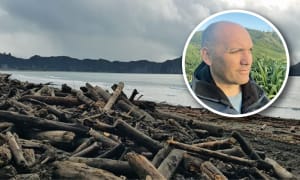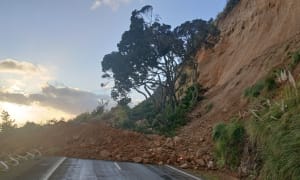A jet boat has joined an effort to get rid of woody debris from the banks and within the Waimatā River.
Working alongside chainsaw operators, an excavator team and a helicopter, the clean-up project is tackling almost 30km of riverbank.
The initiative is part of a wider regional programme to clear waterways and coastal areas of woody debris that washed across Tairāwhiti during Cyclone Gabrielle.
It follows specialised drone work in May that captured details of where the debris was located.
Gisborne District Council community lifelines director Tim Barry said there had been significant progress with the Waimatā River work but it was weather-dependent.
“There is 28.4km of riverbank to clear of logs, and 95% (27km) has already been chopped up into manageable pieces, which are then picked up by helicopter and taken to one of six burn pits established between Waikereru Bridge and the Donaldson farm at Darwin Rd.”
About 60% of the riverbank has also been revisited since the June 24 weather event to address additional debris and some that has moved.
The helicopter can extract a piece of wood every 1.5 to 1.8 minutes and take up to 1.3 tonnes in weight.
“There’s only one pilot who flies the helicopter and controls the grapple to lift the woody debris.
“This highly skilled work is likely to be very visible over the next few weeks as we reach the lower part of the river close to town.”
The jet boat ferries the chainsaw operators up the river to hard-to-reach places so they don’t have to access private property.
A side-by-side vehicle is also being used to cross farm tracks where possible.
Work will take a further three to four weeks to complete, however, the helicopter could stay on and work around the weather.
The helicopter started at Waikereru Bridge and has already moved 700 of about 2500 tonnes (28%) to disposal/treatment sites.
Barry says the jet boat has been invaluable for the operation.
“It’s also going to be crucial for our excavator crew, who will remove some of the logs while they’re still in the water — as the riverbed sediment allows.
“This in-river work can only proceed when the helicopter is operational to prevent downstream floating of the logs that have been freed.”
The total amount of woody debris removed across Tairāwhiti in the region-wide clean-up had reached 420,750 tonnes as of July 7.
Of that, 379,954 tonnes have been treated via high oxygen burning, open-air burning, or chipping while 64,738 tonnes have been removed from beaches.












0 comment
JOIN THE CONVERSATION
Read and post comments with a
Newsroom Pro subscription.
Subscribe now to start a free
28-day trial.